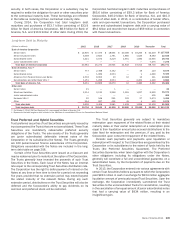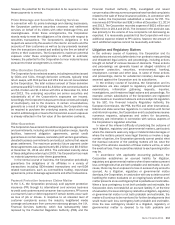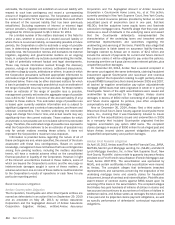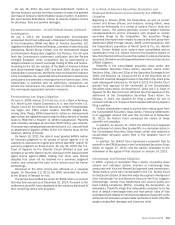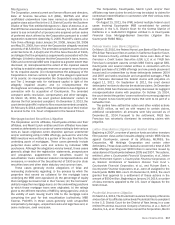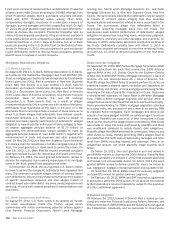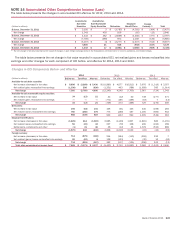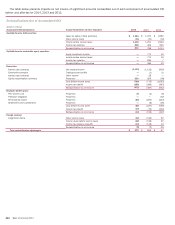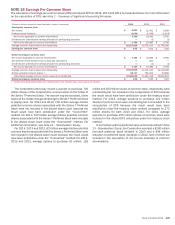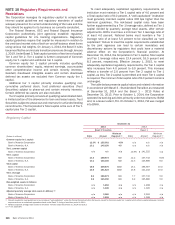Bank of America 2014 Annual Report Download - page 218
Download and view the complete annual report
Please find page 218 of the 2014 Bank of America annual report below. You can navigate through the pages in the report by either clicking on the pages listed below, or by using the keyword search tool below to find specific information within the annual report.216 Bank of America 2014
On October 19, 2012, defendants settled the matter. The
settlement provides for, among other things, (i) payments by
defendants to the class and individual plaintiffs totaling
approximately $6.6 billion, allocated proportionately to each
defendant based upon various loss-sharing agreements; (ii)
distribution to class merchants of an amount equal to 10 bps of
default interchange across all Visa and MasterCard credit card
transactions for a period of eight consecutive months, to begin by
July 29, 2013, which otherwise would have been paid to issuers
and which effectively reduces credit interchange for that period of
time; and (iii) modifications to certain Visa and MasterCard rules
regarding merchant point of sale practices.
The court granted final approval of the class settlement
agreement on December 13, 2013. Several class members
appealed to the U.S. Court of Appeals for the Second Circuit. In
addition, a number of class members opted out of the settlement
of their past damages claims. The cash portion of the settlement
was adjusted downward as a result of these opt outs.
The Corporation is named in three of the opt-out suits, including
one brought by cardholders, and, as a result of various sharing
agreements from the main Interchange litigation, the Corporation
remains liable for any settlement or judgment in opt-out suits where
it is not named as a defendant. All but one of the opt-out suits
filed to date have been consolidated in the U.S. District Court for
the Eastern District of New York. On July 18, 2014, the court denied
defendants’ motion to dismiss opt-out complaints filed by
merchants, and on November 26, 2014, the court granted
defendants’ motion to dismiss the Sherman Act claim in the
cardholder complaint.
LIBOR, Other Reference Rate and Foreign Exchange
(FX) Inquiries and Litigation
The Corporation has received subpoenas and information requests
from government authorities in North America, Europe and the Asia
Pacific region, including the DoJ, the U.S. Commodity Futures
Trading Commission (CFTC) and the FCA, concerning submissions
made by panel banks in connection with the setting of LIBOR and
other reference rates. The Corporation is cooperating with these
inquiries.
In addition, the Corporation and BANA have been named as
defendants along with most of the other LIBOR panel banks in a
series of individual and class actions in various U.S. federal and
state courts relating to defendants’ LIBOR contributions. All cases
naming the Corporation have been or are in the process of being
consolidated for pre-trial purposes in the U.S. District Court for
the Southern District of New York by the JPML. The Corporation
expects that any future cases naming it will similarly be
consolidated for pre-trial purposes. Plaintiffs allege that they held
or transacted in U.S. Dollar LIBOR-based derivatives or other
financial instruments and sustained losses as a result of collusion
or manipulation by defendants regarding the setting of U.S. Dollar
LIBOR. Plaintiffs assert a variety of claims, including antitrust and
Racketeer Influenced and Corrupt Organizations (RICO), common
law fraud, and breach of contract claims, and seek compensatory,
treble and punitive damages, and injunctive relief.
In a series of rulings, the court dismissed antitrust, RICO and
certain state law claims, while permitting the Commodity Exchange
Act and other state law claims to proceed. As a result of a
procedural ruling by the Supreme Court, plaintiffs are pursuing an
immediate appeal of the dismissal of their antitrust claims. Further,
based on the statute of limitations, the court has substantially
limited the time period for which manipulation claims under the
Commodity Exchange Act may be pursued. As to the Corporation
and BANA, the court has also dismissed manipulation claims
based on alleged trader conduct, and certain common law claims
by plaintiffs who alleged no direct dealings with the Corporation
or BANA. Other claims against the Corporation and BANA remain
pending, however, and the court is continuing to consider motions
regarding them, including the applicability of its prior rulings to
subsequently filed actions.
Certain regulatory and government authorities in North
America, Europe and the Asia Pacific region are conducting
investigations and making inquiries of a significant number of FX
market participants, including the Corporation, regarding FX
market participants’ conduct and systems and controls over
multiple years. The Corporation is cooperating with these
investigations and inquiries, some of which are likely to lead to
regulatory or legal proceedings and expose the Corporation to
material penalties, fines or losses, and could adversely affect its
reputation.
In particular, in November 2014, the Corporation resolved a
matter with the Office of the Comptroller of the Currency (OCC) by
agreeing to the imposition of mandatory remedial measures and
payment of $250 million in civil penalties associated with the
Corporation’s FX business and its systems and controls.
The Corporation is in separate advanced discussions to resolve
the regulatory matters of concern to another U.S. banking regulator
involving the Corporation’s FX business and its systems and
controls. There can be no assurances that these discussions will
lead to a resolution, or of the amount or timing of any such
resolution.
In addition, in a consolidated amended complaint filed on
March 31, 2014, the Corporation and BANA were named as
defendants along with other FX market participants in a putative
class action filed in the U.S. District Court for the Southern District
of New York on behalf of plaintiffs and a putative class who
allegedly transacted in FX and are domiciled in the U.S. or
transacted in FX in the U.S. (the U.S. Action). On April 30, 2014,
a substantively similar class action was filed against the
Corporation and other FX market participants on behalf of a plaintiff
and putative class allegedly located in Norway (the Foreign
Action). The complaints allege that class members transacted with
defendants at or around the time of the fixing of the WM/Reuters
Closing Spot Rates or entered into transactions that settled in
whole or in part based on the WM/Reuters Closing Spot Rates
and that they sustained losses as a result of the defendants’
alleged conspiracy to manipulate the WM/Reuters Closing Spot
Rates. Plaintiffs in the U.S. Action assert a single claim for
violations of Sections 1 and 3 of the Sherman Act, and plaintiff in
the Foreign Action asserts claims for violations of the Sherman
Act, as well as certain claims under New York statutory and
common law. Plaintiffs seek compensatory and treble damages,
and declaratory and injunctive relief.
On January 28, 2015, the court denied defendants’ motion to
dismiss the U.S. Action, finding that plaintiffs had sufficiently
pleaded the elements of an antitrust claim. In the same decision,
the court granted with prejudice defendants’ motion to dismiss
the Foreign Action, finding that the Sherman Act does not apply
extraterritorially, except in limited circumstances not present in
the case, and that plaintiff had failed to plead an actionable state
law claim.





